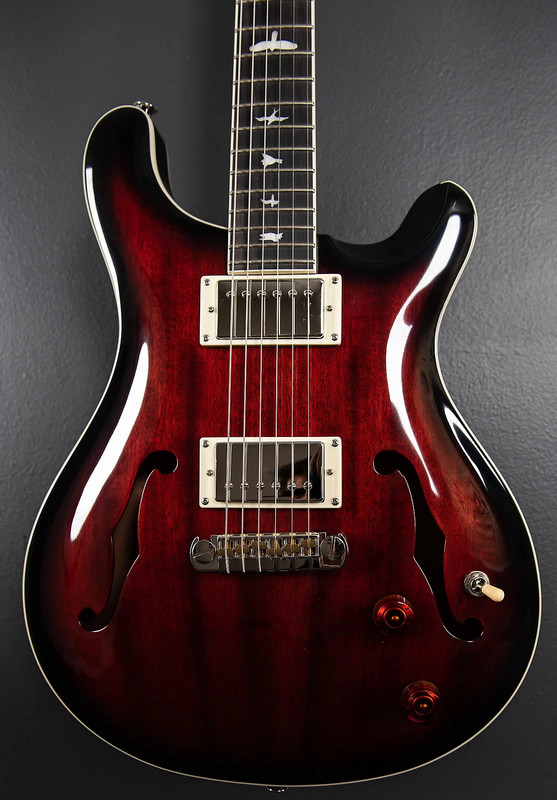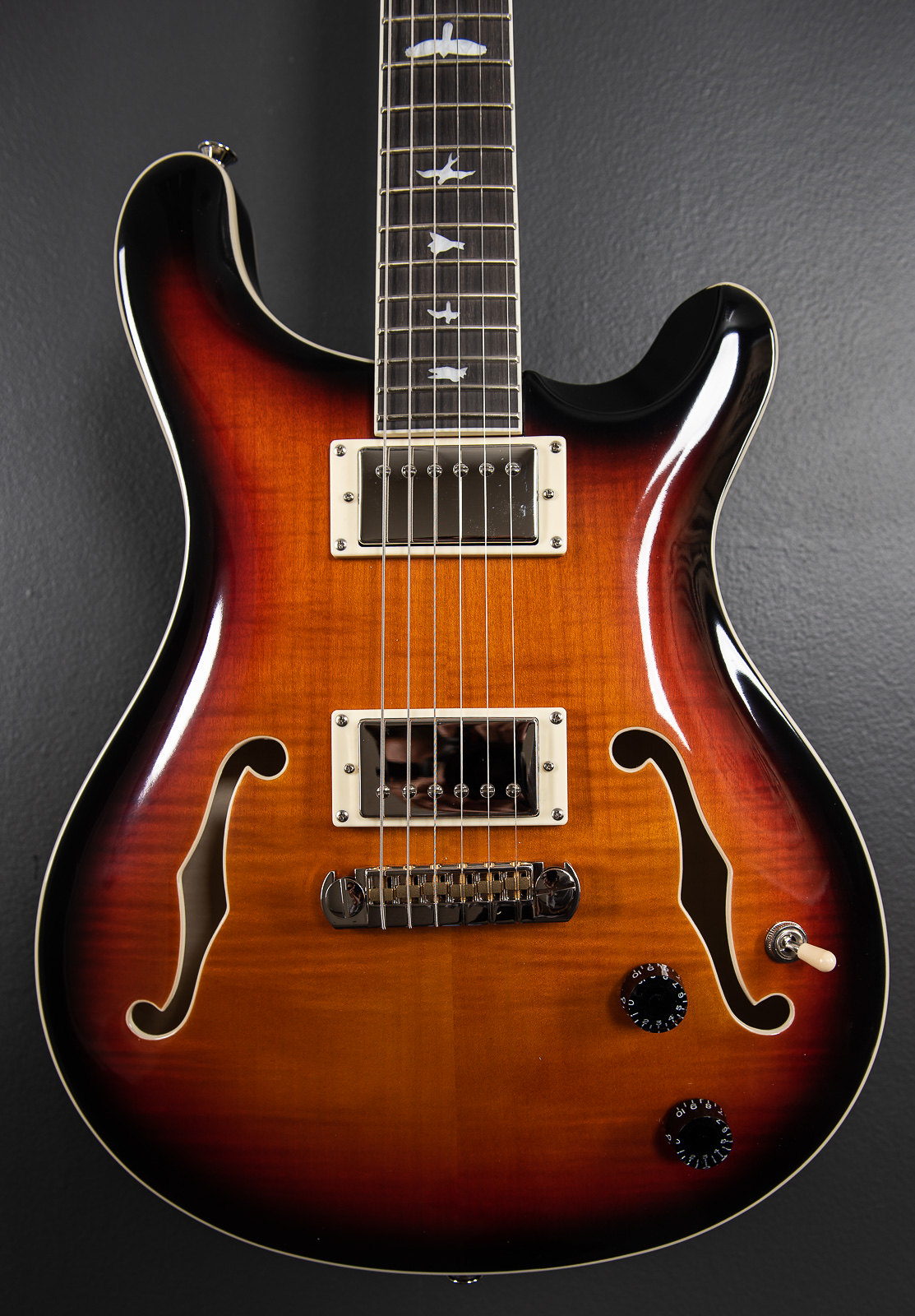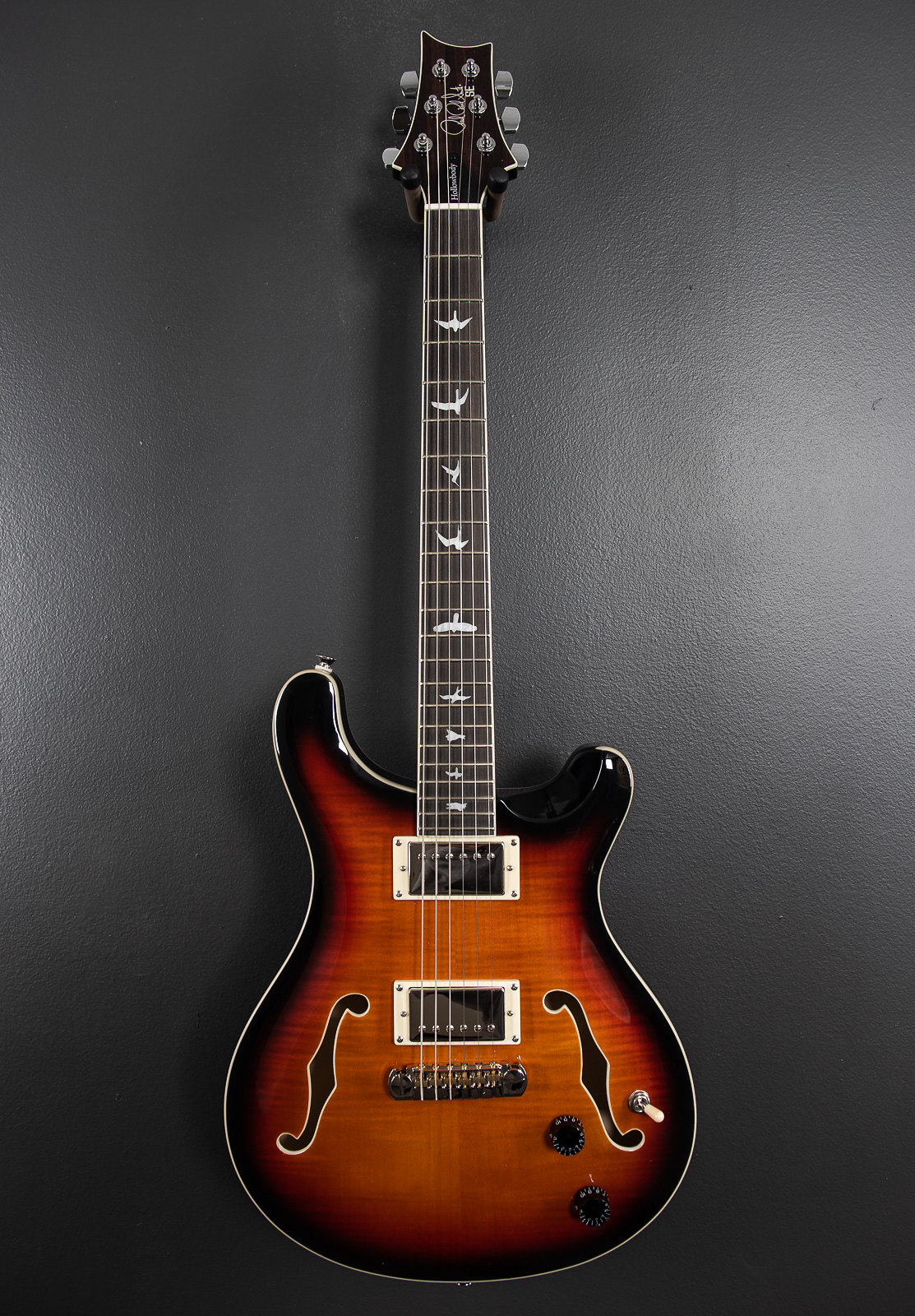Last night I received my Hollowbody II Piezo in Peacock Blue Smokeburst. I learned about this guitar maybe 2 weeks ago, and it was difficult to wait that long to do the necessary research (I live on an island in complete lock down, so I couldn't just go to a guitar store and try one.)
Information about these guitars is getting out, so I'll just comment on what I found:
0) This guitar is very musical and responsive. t doesn't have the 'woodiness' of the Standard, but there's still this touch of 'hollowness' that's just so effing sweet it gives me chills. I should mention my tone is very clean. The guitar is also really enjoyable to play unplugged. It is absolutely adequate for practicing certain things or just playing late night when it needs to be quiet.
1) This is a real (full) hollowbody. The top, back, and sides are all separate pieces joined by kerfed linings as with acoustic guitars. The 'block' in the middle is literally the size of the bridge, no larger, and is a separate piece of material from any other part of the guitar. There is also longitudinal bracing, along the top only, from the block to the neck. There is a lot of web misinformation regarding hollow vs semi-hollow which I'll elaborate on below.
2) If you look inside the F-holes, the inside of the back is also flamed maple. I wasn't expecting that. I was wondering why the insides weren't painted or dyed, but now I'm glad. I know the top and back are laminated, but I don't know if they laminated 'regular' maple and put a veneer on both sides, or if they actually laminated layers of flamed maple.
3) I have ridiculous attention to detail, to the point it feels like a disease sometimes. Anyway, even with Paul's signature on the headstock I wasn't expecting this level of attention to detail on an SE made in China. The natural flamed maple binding is beautiful and the lines are very, very clean. Also the finish on this guitar is appropriately thin, which is uncommon for imported guitars. It's not buffed as well as a USA made guitar but it's very acceptable. The neck joint is exceptionally clean with no build up of acrylic urethane.
4) The action is perfect, as in if you hold down the 1st and 22nd fret and measure the gap at the 12th fret, it's within PRS spec. There is no fret buzz. The pickup height seems appropriate and there is good balance between neck and bridge pickup volume.
5) I'm realizing there are too many variables to trust online sound demos. These pickups sound good with my rig. I thought I'd want to change them right away, but I'm really enjoying the sound. I play through an Effectrode Blackbird pre (all tube at appropriate plate voltage) and into Two Notes CAB M. The bridge pup has bight without being too sharp, and the neck pup is mellow and woody without being dry or boring. They compliment each other really well. Honestly I've played with it for one night and am already more comfortable and proficient making tonal adjustments than ever before.
6) It seems like there's less real estate between the E strings and the edge of the fret board than I'm used to, but I've always done bends toward the middle so it shouldn't matter.
7) The neck feels every bit of 'fat' but without being a baseball bat.
8) The 'fat' neck, made of dense mahogany and with a dense ebony fretboard is heavy, at least in comparison to the very light body. There is some neck dive. With a cheap nylon strap and a dryfit shirt the guitar was uncomfortable to play, but a few small adjustments will help (grippier strap, lighter tuning buttons, possibly a heavy strap lock or small weight on the strap.)
9) The tuners are made by Jin-Ho (according to John Mann) and it's difficult to find plastic buttons. However they feel and track very nice, and based on some measurements are probably as light as any other electric tuner with the exception of Gotoh Stealth and possibly Phase 3. (For the record I weighed a bunch of tuners yesterday, and all the latest mini tuners are pretty close to 21 grams without the button. I have Hipshot open back which look light, but their weight savings is actually in the T shaped button, the body ends up being the same as all the others.)
10) The volume knob seems to roll off pretty quick. But the guitar doesn't lose much tone with volume changes. The pots feel light (easy to turn) but they're not the quietest pots (they're quiet with regards to the signal, but make mechanical noise you can hear when turning and not playing.) The switch feels adequate, not particularly good or bad.
I haven't actually used the Piezo yet. I haven't had or played a guitar in awhile and I wore my left hand out before I could get there!


Hollowbody guitars: There are 2 types of full hollowbody guitars: One is like the jazzy archtops, built like an acoustic or a violin, where the top, back, and sides are all separate pieces. They're joined around the edges by kerfed linings, and there is bracing along the top and bottom to support string tension. Archtop guitars usually have tail pieces attached at the butt of the guitar, since there's no solid material in the middle to anchor the bridge. PRS employs that build method on this guitar, except that instead of bracing the bottom, there's a small block that attaches the top to the bottom. This block is the size of the bridge, no bigger, so the top and bottom can resonate independently for 90-something percent of their surfaces, and there's a place to install a stoptail bridge. This method is expensive and time consuming due to the joinery, but there is greater control of the thickness of the back and sides of the guitar since they can be thickness sanded prior to assembly.
The second kind of full hollowbody is made from a solid body that is completely routed out except along the edges, and a center block if (likely) used. So here the sides and back are of the same piece of material, as would be the 'block' under the bridge. The key here is that the guitar is hollowed out on all sides of the block - toward the pickups and strap button, as well as the sides. With CNC this is the less expensive method. If done by hand, it takes a ton of time and attention to get the top and bottom uniformly and adequately thin. Less expensive guitars made this way have very thick tops and/or bottoms, sacrificing quality and tone for durability and minimal manufacturing mishaps.
Semi-hollow guitars: People commonly say "oh it has a block, so it's semi-hollow". But the block they're usually referring to is not a block, but the whole center of the guitar that hasn't been machined away. Semi-hollow technically also means semi-solid. Basically, this is a solid bottom that has routing done on the sides to create chambers, typically under F-holes, but leaves the center of the guitar solid to support the string loads. This style is not hollow between the bridge and bottom strap pin, nor is it hollow between the bridge and bridge pickup. The top is attached to the bottom in the center for the entire length of the guitar, from the neck to the strap button. These guitars are lighter than solid bodies and will resonate more, but they resonate as a whole, whereas a fully hollow guitar can have more independent resonance in the top and bottom. Obviously less machining means cheaper and faster to make. More solid means more structure, so a more durable guitar. But often the tops on these are very thick, the center section is large, and the result is not much resonance. I've had beautiful semi-hollow guitars that felt, played, and sounded like solidbodies.
I'm making a big deal about this because (well, I care) the PRS SE Hollowbody does have a real 'block' but shouldn't be confused with a semi, which people often describe as having a 'block' which is actually the solid half of a 'semi' hollow guitar body.








